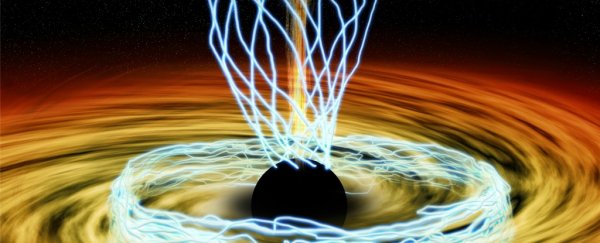Black holes are among the most mysterious objects in the Universe. But they have one thing in common - most of the black holes we've found fall into two categories: small, stellar black holes with the mass a few times more than our Sun; or supermassive black holes that weigh the equivalent of millions of billions of Suns.
But researchers have just announced further evidence of a new type of black hole, called an 'intermediate-mass black hole', weighing a moderate 2,200 Suns, and hidden in a dense cluster of stars.
Researchers had previously predicted that these intermediate-mass black holes (IMBH), weighing between 100 to 10,000 Suns, could exist in our Universe.
But astronomers have only spotted a handful of IMBH candidates, so this new observation is pretty exciting.
Mid-sized black holes are thought to hold some important clues about how the supermassive black holes we see at the centres of galaxies today ended up getting so big - something that can't be easily explained by our current understanding of physics.
"We want to find intermediate-mass black holes because they are the missing link between stellar-mass and supermassive black holes," said lead researcher Bulent Kiziltan from the Harvard-Smithsonian Centre for Astrophysics.
"They may be the primordial seeds that grew into the monsters we see in the centres of galaxies today."
The new intermediate-mass black hole was spotted hiding at the centre of the globular star cluster known as 47 Tucanae.
47 Tucanae is located only 13,000 light-years from Earth - relatively close, in space terms - and contains the southern constellation of Tucana the Toucan.
The star cluster contains thousands of stars, and about two dozen pulsars, in a ball only about 120 light-years in diameter, and researchers have long been searching for signs of a black hole at its centre.
Black holes are thought to form when stars collapse in on themselves at the end of their lives, so with so many stars crammed into such a dense space, it seemed like a prime candidate.
But spotting a black hole in a globular star cluster is harder than it sounds, because black holes have such huge gravity that they suck up matter without allowing anything visible light to escape - hence the name "black".
Usually, astronomers spot black holes by looking for X-rays, which shoot out of the hot disk of material that surrounds black holes.
But the method only works when black holes are actively feeding on nearby gas. Because the centre of 47 Tucanae is gas-free, any black hole at its centre would effectively be starving, causing the black hole to remain hidden.
Another strategy would be to spot the black hole due to its influence on nearby stars - that's how we spotted the black hole at the centre of our galaxy - but because 47 Tucanae is so crowded, that didn't work either.
"Intermediate-mass black holes have been expected [in globular clusters] for many decades," Kiziltan told Space.com. "But we've not been able to find one conclusively."
In the new study, the team took two different approaches to finally nail down the IMBH. First, they monitored the overall motion of stars throughout the cluster rather than just looking at one or two.
The team noted that something dense was acting like a cosmic 'spoon' that was stirring the pot of stars, causing stars to slingshot to higher speeds and greater distances. The likeliest explanation for this activity was a black hole.
They backed up these observations by looking at the pulsars within the star cluster - pulsars are remnants of dead stars that send out bright blasts of radio signals.
The pulsars in 47 Tucanae were also getting flung about - something that couldn't be explained unless there was a black hole in their midst.
Using computer models, they were able to calculate that the globular star cluster must contain an intermediate-mass black hole about
Combined, the evidence suggests the presence of an IMBH weighing about 2,200 solar masses - taking into account the margin of error, the upper range of their calculations suggest it could be up to 3,700 solar masses, and as low as 1,400 solar masses.
All those numbers put it safely within the criteria of an IMBH.
The researchers will continue to study this new type of black hole to get some insight into how it works. But they think the technique could be used to find more IMBHs in the Universe - given how long this black hole eluded detection, the team suggests many other globular clusters could be hiding the unique objects.
The more we find, the closer we'll get to understanding how supermassive black holes came to be - and hopefully solving some of the other mysteries that surround how black holes work.
The research has been published in Nature.
